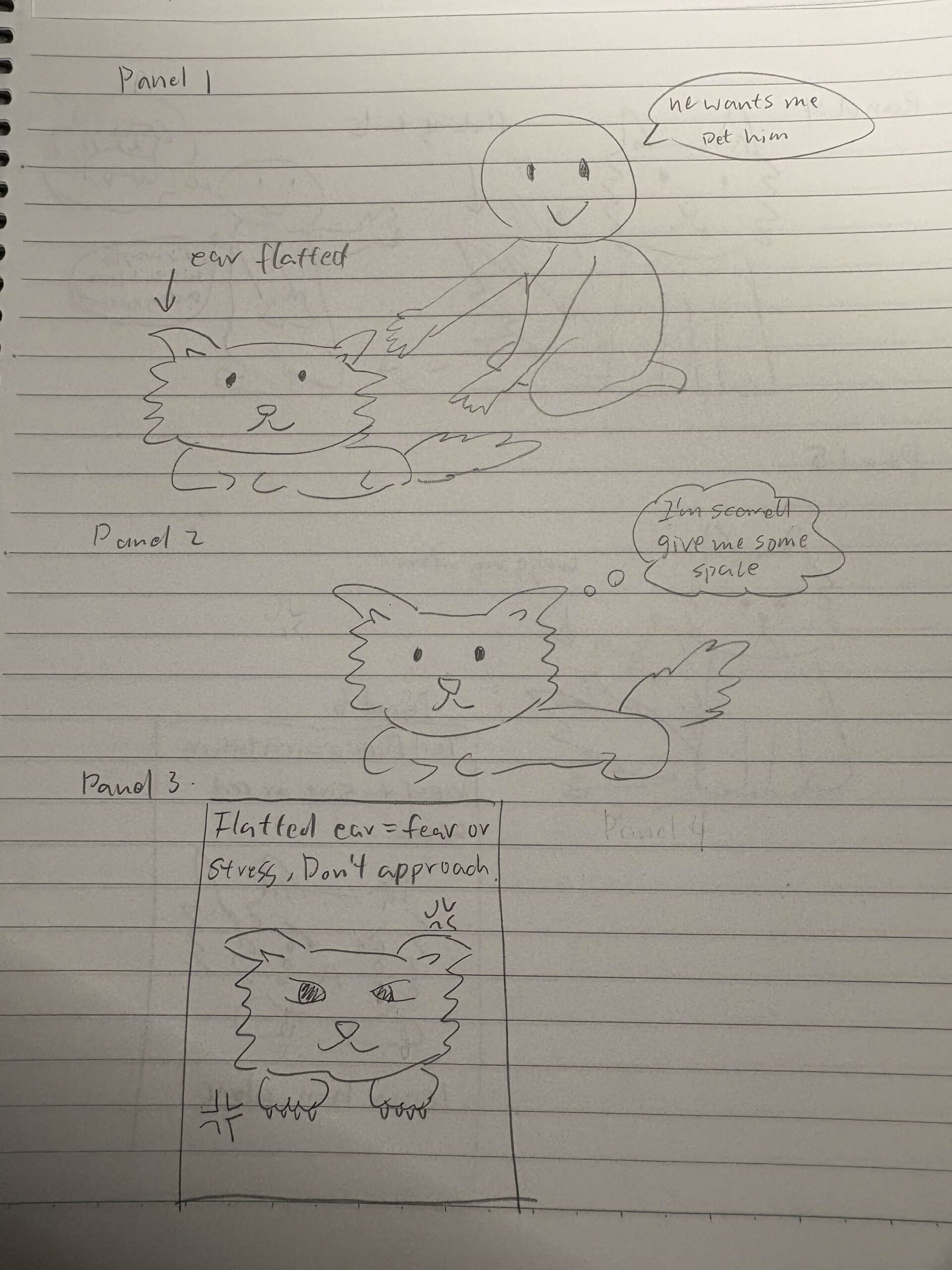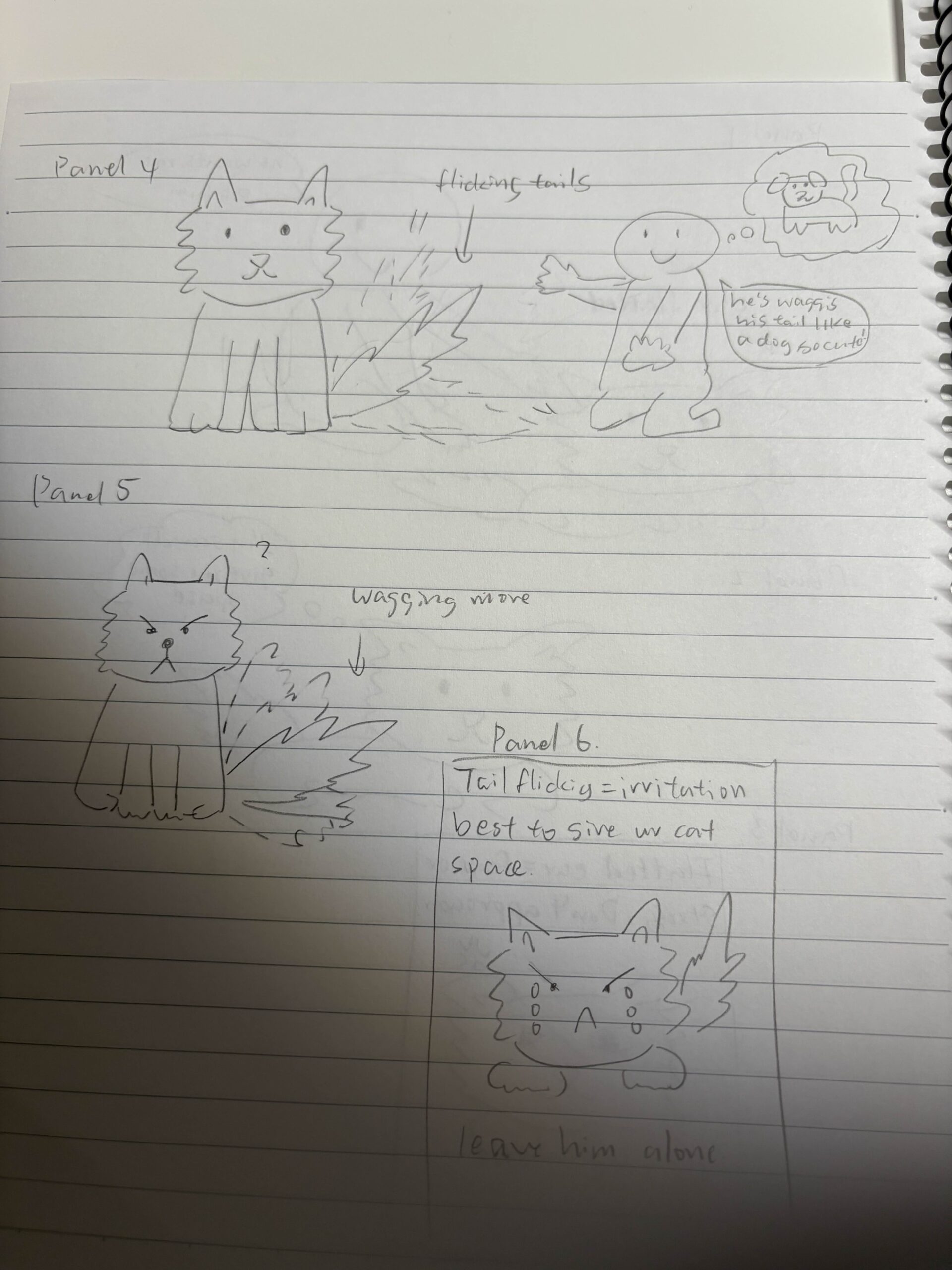Prototype
Cat Body Language 101
September 17, 2025
Nico Cai
Introduction
The inspiration for my comic comes from my own Maine Coon. When he was a kitten, I often couldn’t understand his body language and sometimes misread what he wanted. As we spent more time together, our communication slowly became more in sync. I realized that although you can’t talk to a cat directly, you can build a stronger bond by learning to read their signals. I hope people could better understand their feline friend through this cosmic.
Understand Phase
Challenge
Many new cat owners may misread their cat’s body language. Unlike dogs, cats flicking tails to show the signal of warning instead of being friendly. Misunderstanding these cues can lead to scratches, bites, or broken trust between cats and their humans.
Audience
This comic is intended for a broad audience of cat owners of all ages, from children who are born in a family with cats to first-time cat owners. For younger readers, the comic offers simple and engaging visuals that can spark curiosity and promote safe interactions with cats. For adults, it provides practical reminders and clarifications that can improve their everyday relationships with their pets. This cosmic’s target readers also include people who prefer quick, visually engaging resources such as comics, memes, or short social media posts instead of reading lengthy articles or books.
POV
New cat owners need to learn how to correctly interpret common cat body language cues so that they can build trust, avoid conflict, and create a safer, more loving environment for their pets.
Learning Objectives
By the end of this comic, learners will be able to:
- Recognize at least three common cat body language signals: ears back, tail flicking, and belly showing.
- Distinguish between behaviors that indicate trust versus those that indicate stress.
- Apply this knowledge in daily interactions in order to lead to safer and more positive human-cat relationships.
- Develop a deeper empathy for your cat’s emotions and become a more responsible pet owner. (Hidden objective)
Plan Phase
Ideation
When I was brainstorming for this project, I remembered asking my breeder why my kitten was “making noises.” The breeder explained that the kitten was actually purring because he felt happy and comfortable, and that these sounds were a way of interacting with me, which sometimes even to signal hunger. This experience sparked my interest in understanding cat body language more deeply. Most of what I have learned since then has come from YouTube videos and RedNote posts that explain feline behavior in simple, engaging ways.
The most promising prototype I developed is a comic that highlights three commonly misunderstood cat signals: flattened ears, tail flicking, and belly showing, using humor and short explanations to help owners interpret them correctly.
Scripts
Panel1-6


Panel 7
Visual: Cat rolls onto its back, belly exposed
Text: Owner: “Wow, he wants a belly rub!”
Misinterpretation
Panel 8
Visual: Owner reaches out, cat bats the hand away
Text: Cat’s thought: “Not a chance!”
Exposed belly ≠ invitation
Panel 9
Visual: Info card
Text: Caption: “Exposed belly = trust, but not an invitation to touch.”
Correct explanation
Panel 10
Visual: Cat’s pupils suddenly dilate (big round eyes)
Text: Owner: “Why do his eyes look so scary?!”
Misinterpretation
Panel 11
Visual: Cat crouches, ready to pounce on a toy
Text: Cat’s thought: “Play time!”
Dilated pupils = excitement/play mode
Panel 12
Visual: Info card
Text: Caption: “Dilated pupils = excitement or play mode.”
Correct explanation
Panel 13
Visual: Owner reflects, thought bubbles show four signals (ears, tail, belly, eyes)
Text: Owner: “I guess I’ve been reading him wrong…”
Learning moment
Panel 14
Visual: Tip card with four icons (ears, tail, posture, eyes)
Text: Caption: “Check the ears → tail → posture → eyes.”
Simple summary
Panel 15
Visual: Cat calmly lying on owner’s lap
Text: Owner: “Now we understand each other better.”
Happy ending
Principle
This comic uses some educational multimedia design principles to make the content clear and engaging. Each panel follows the coherence principle by focusing only on one cat body signal without distractions. Signaling is used through arrows and caption cards to highlight important features and contiguity ensures that text is placed directly beside the corresponding images. The story is also segmented into four short scenes, each teaching a single behavior, which helps readers process information step by step. Finally, the cat’s humorous “inner voice” adds a personalization effect, making the learning experience more memorable.